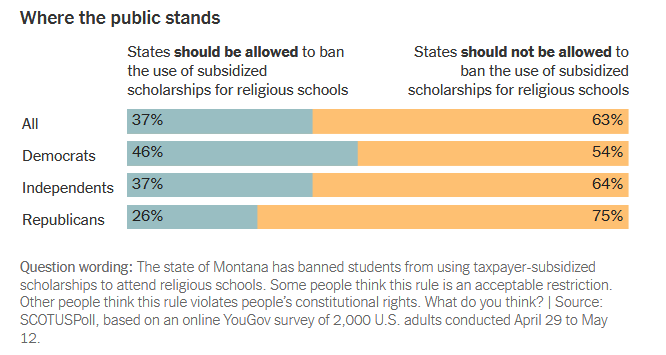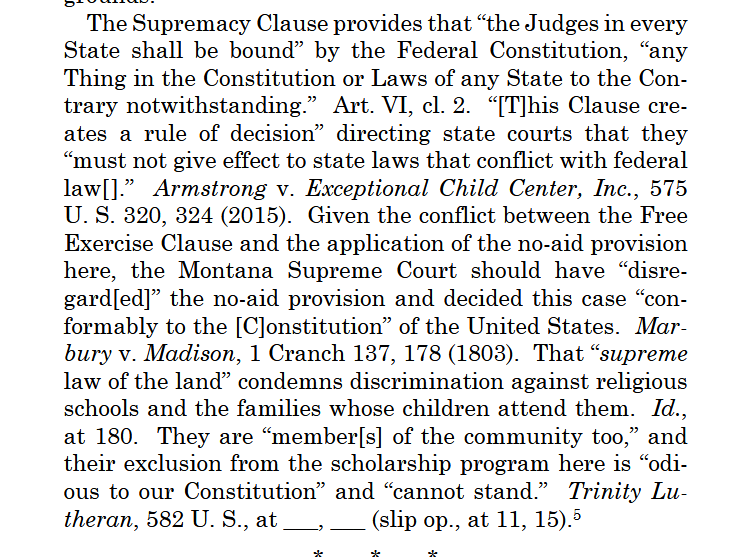A few thoughts on today’s Espinoza decision, which appears to invalidate most state constitutions’ no-aid clauses, which prohibit public dollars flowing to religious bodies. 38 states have such clauses. https://www.scotusblog.com/2020/06/symposium-rip-state-blaine-amendments-espinoza-and-the-no-aid-principle/">https://www.scotusblog.com/2020/06/s... 1/21
This is a major victory for accommodationists (those who favor closer church-state ties), who have sought this goal for many years. And in doing so they have dealt a major blow to the institutional foundations of strict separation. 2/21
The US is amidst a transformation of how it governs church-state relations—what sociologists of religion term its “secular settlement.” I& #39;ve written about how these settlements reflect how political conflicts play out in institutional contexts https://www.amazon.com/Secular-Conversions-Political-Institutions-Religious/dp/110750323X">https://www.amazon.com/Secular-C... 3/21
The strict separationist settlement we grew up with only dates from WWII and reflects midcentury religious politics. It was deliberately advanced through the courts by a coalition of Jews, civil libertarians, and evangelicals in a grassroots legal movement. 4/21
The politics of religious conflict have long since shifted. Conservative Protestants, Catholics, and Jews now align and appoint justices who favor accommodationist jurisprudence. The conservative bloc that wrote Espinoza is the product of these shifts. 5/21
As the New York Times reported today, this decision is also in line with public opinion, which has never been as separationist as SCOTUS jurisprudence: https://www.nytimes.com/2020/06/30/us/supreme-court-religious-schools-aid.html">https://www.nytimes.com/2020/06/3... 6/21
But separationists were able to press their case because the courts were an inviting institutional target: they were accessible in ways that allowed groups like the ACLU, American Jewish Congress, and Baptist Joint Committee to promote separationist jurisprudence. 7/21
Taxpayer standing allowed them to have their cases heard before the courts, state constitutional provisions provided them with additional grounds to challenge accommodationist laws, and a strong public-private divide allowed church and state to be distinguished. 8/21
These institutional features of American law provided a legal opportunity structure that separationists used first to build strict separation, and then later as a fallback to defend it from accommodationist countermobilization. 9/21
As accommodationists have challenged the separationist settlement, they have smartly focused not only on expanding Free Exercise jurisprudence, but also on undermining those institutional supports for strict separation. 10/21
First, taxpayer standing has been steadily whittled away in cases like Hein and Winn, which means many challenges to aid to religious bodies cannot even be heard in court. https://www.acslaw.org/wp-content/uploads/2018/04/Green_-_Establishment_Clause.pdf">https://www.acslaw.org/wp-conten... 11/21
Second, accommodationists have developed novel policies like scholarship tax credits that blur the public-private divide by hiding the role of the state, and which have been upheld by the courts as the exercise of individual choice (an argument reiterated today, p. 19) 12/21
But even as these other institutional supports were weakened, state constitutional provisions had held on as a kind of backstop that separationists could draw upon to insist on stricter ch/st separation. Many voucher schemes were invalidated on state constitutional grounds. 13/21
For this reason, accommodationists have long sought their elimination, rechristening them “baby Blaine” amendments to associate them with the 1876 anti-Catholic Blaine Amendment that was nearly added to the Constitution. https://www.amazon.com/Bible-School-Constitution-Church-State-Doctrine/dp/0199827907">https://www.amazon.com/Bible-Sch... 14/21
If state no-aid clauses are unconstitutional, then a major final institutional defense for separationists disappears. Accommodationists came close to gutting them in 2004’s Locke case, and again in 2017’s Trinity Lutheran case. Today, they succeeded. 15/21
Espinoza basically renders “baby Blaine” clauses a dead letter. Any provision that singles out religious bodies as ineligible for funding is held to violate the First Amendment’s free exercise clause and is presumptively unconstitutional (p. 22). 16/21
This removes one of the last institutional buttresses of strict separation. Separationists can no longer rely on state amendments to challenge payments to religious schools, or even churches. Espinoza clears the way for funds to flow to religious bodies. 17/21
This money was already flowing, but it is now clear that 2017’s Trinity Lutheran case is now central to the evolving new accommodationist regime. Any program that funds nonstate actors cannot exclude religious bodies from those programs. https://www.supremecourt.gov/opinions/16pdf/15-577_khlp.pdf">https://www.supremecourt.gov/opinions/... 18/21
In the bigger picture, however, the institutional supports for strict separation have now all been fatally compromised, at least when it comes to funding of religious bodies. The new secular settlement on the horizon for many years appears to have arrived. 19/21
Separationists are now in a position similar to that of accommodationists 70 years ago. The courts should no longer be considered friendly terrain. They will need to pursue remedies in other venues, and develop new legal arguments on the terrain defined by accommodationists 20/21
If you& #39;ve read this far and want to read more in this vein, grab a copy of my book! https://www.amazon.com/Secular-Conversions-Political-Institutions-Religious/dp/1107103711">https://www.amazon.com/Secular-C... 21/21 FIN

 Read on Twitter
Read on Twitter




